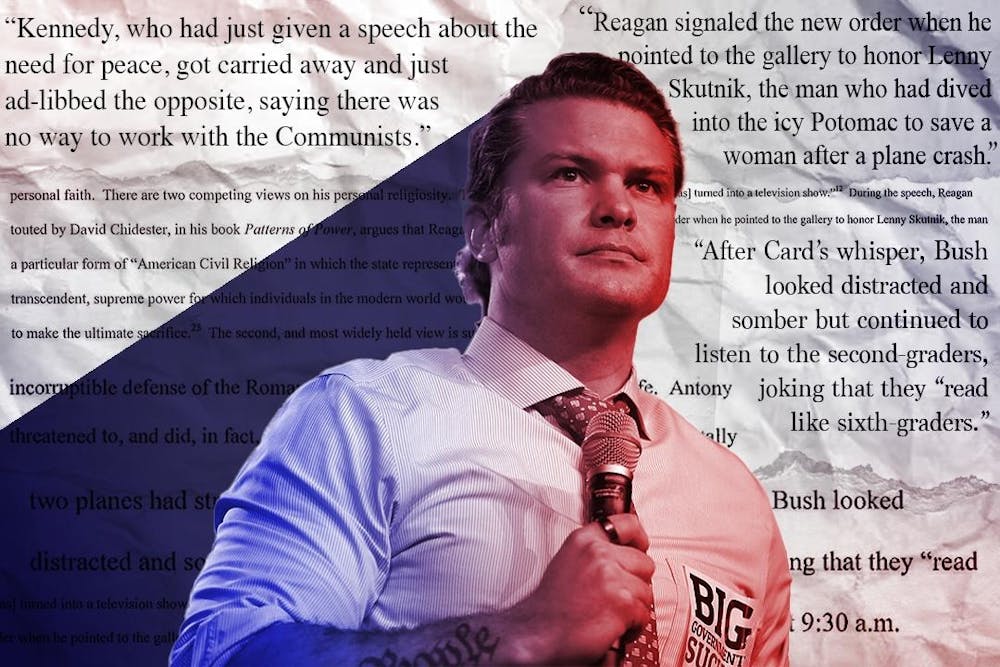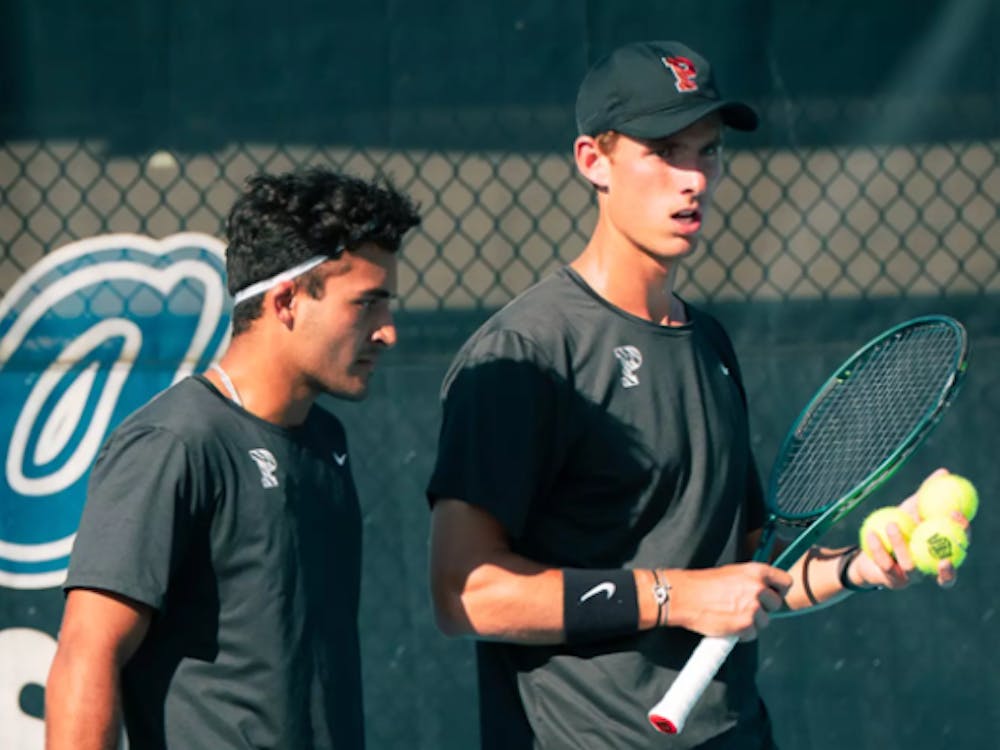“After Card’s whisper, Bush looked distracted and somber but continued to listen to the second-graders, joking that they ‘read like sixth-graders,’” reads the senior thesis authored by Pete Hegseth ’03, now the U.S. Secretary of Defense.
This sentence is notable for recapping the precise moment President George W. Bush was informed of the 9/11 attacks. But it is also notable because it is nearly identical to one published by The Washington Post in 2001, two years before Hegseth wrote his thesis.
“After Card’s whisper, Bush looked distracted and somber but continued to listen to the second-graders read and soon was smiling again. He joked that they read so well, they must be sixth-graders,” the story in The Post reads.
The article is not cited in Hegseth’s paper.
A review of Hegseth’s thesis by The Daily Princetonian, in consultation with three experts on plagiarism, found eight instances of uncredited material, sham paraphrasing, and verbatim copying. But while the three experts all said that the passages violated Princeton’s academic honesty regulations, they differed on whether the violations were serious or too minor to matter.
“There’s no silver bullet here; there’s no smoking gun in terms of a deep example of plagiarism,” James M. Lang, the author of “Cheating Lessons: Learning from Academic Dishonesty,” told the ‘Prince.’ “It’s a borderline case.”
Spokespeople from the Department of Defense did not respond to multiple requests for comment from the ‘Prince’ prior to publication. Following the publication of this article, Chief Pentagon Spokesperson Sean Parnell provided a statement to Konstantin Toropin, a reporter for military.com.
“Secretary Hegseth has written five books. He’s written hundreds of papers and op-eds. During the confirmation process, every word was reviewed by top left-wing law firms working in conjunction with every media outlet in the country. They found no plagiarism because there was no plagiarism,” Parnell wrote. “This is a fake story designed to distract from the DoD’s historic accomplishments under President Trump and Secretary Hegseth’s leadership.”
The ‘Prince’ requested a digital copy of the 90-page thesis, submitted on April 8, 2003, from the Mudd Manuscript Library, which generally makes senior theses available to anyone with a Special Collections research account. The senior thesis represents the capstone of the Princeton undergraduate experience and is a graduation requirement for almost all students.
Entitled “Modern Presidential Rhetoric and the Cold War Context,” Hegseth’s work, submitted to the Department of Politics, analyzes the evolution of presidential speeches from the Cold War to the War on Terrorism. His paper argues that modern presidential rhetoric is largely influenced by prevailing global threats, such as the Soviet Union during the Cold War and Al-Qaeda following 9/11.
An analysis of Hegseth’s thesis through several publicly available plagiarism detection models flagged a total of 12 passages spread out throughout the paper.
To further evaluate the passages, the ‘Prince’ consulted three experts in plagiarism research and copyright who have previously analyzed prominent cases of plagiarism involving politicians or have conducted extensive research on academic integrity. All reviewers assessed the thesis without prior knowledge of the author’s identity.

That manual review found eight instances of uncredited material, sham paraphrasing, and verbatim copying, according to the three experts. The four other passages that they flagged, the experts said, were not deemed to be of significance on a standalone basis, but fit a broader pattern of some form of plagiarism.
While the three experts said that all eight passages violate Princeton’s Rights, Rules, Responsibilities, a set of policies and procedures that govern academic integrity and other elements of undergraduate life, they agreed that not all of the instances could be defined as serious plagiarism.
In recent years, writing from public figures spanning Princeton professor Kevin Kruse, former Harvard president Claudine Gay, and Supreme Court Justice Neil Gorsuch has been accused of containing copied or improperly cited or paraphrased text. Journalists, academics, and plagiarism experts have all raised concerns about the growing use of plagiarism allegations as a political weapon in recent years.
“This is very similar to other allegations we’ve seen over the past year and a half or so,” said Jonathan Bailey, who runs the website Plagiarism Today and helped review Gay’s papers for The New York Post.
‘More gray than black and white’
Achieving a consensus on the definition of plagiarism at large is challenging. The three experts interviewed by the ‘Prince’ differed on which passages amount to serious plagiarism and which are too minor to matter.
“I definitely see more gray than black and white here,” Lang said. In his view, about half of the examples constitute a form of serious plagiarism, while the other half seem to be minor violations of Rights, Rules, Responsibilities.
A passage Lang believes constitutes serious plagiarism appears in a section discussing Kennedy’s speeches during the Cold War.
“Kennedy, who had just given a speech about the need for peace, got carried away and just ad-libbed the opposite, saying there was no way to work with the Communists,” Hegseth wrote, using phrases identical to what appears in Richard Reeves’ book “President Kennedy: Profile of Power.”
While Reeves is cited in the paper, including for that particular sentence, no quotations accompany the seemingly identical text. “In his enthusiasm, Kennedy, who had just given a peace speech and was trying to work out a test ban treaty with the Soviets, had gotten carried away and just ad-libbed the opposite, saying there was no way to work with Communists,” Reeves writes.
Lang views the Kennedy sentence as a serious case of plagiarism. “We’re talking 10 or 12 words here … that’s the kind of thing that would raise a flag for me,” he said.
But Bailey does not view this passage, or any of the other seven passages, to be particularly egregious. “Even the ones that were more direct still typically only involve a sentence or two at a time,” Bailey said.
The three experts who reviewed the thesis passages at the request of the ‘Prince’ did, however, unanimously agree that Hegseth’s writing violated Princeton’s Rights, Rules, Responsibilities, which they all agreed contains stricter rules regarding unattributed copying.
“Under the definitions provided by Princeton’s Rights, Rules, and Responsibilities, it is plagiarism,” Guy Curtis, a researcher at the University of Western Australia who studies academic integrity, told the ‘Prince,’ referring to the body of 12 examples he reviewed. Curtis’s research has been widely cited by scholars in the United States and across the globe.
“Once you get 10 to 15 words in a row by ‘accident’ that happens to correspond with something else — it’s probably not accidental,” Curtis added.
Lang agreed: “It’s definitely a violation of Rights, Rules, and Responsibilities — there’s no question about that.”
Section 2.4.6 of Princeton’s Rights, Rules, Responsibilities stipulates that “any quotations, however small, must be placed in quotation marks or clearly indented beyond the regular margin. Any quotation must be accompanied (either within the text or in a footnote) by a precise indication of the source — identifying the author, title, place and date of publication (where relevant), and page numbers. Any sentence or phrase which is not the original work of the student must be acknowledged.”
On paraphrasing, 2.4.6 states that “any material which is paraphrased or summarized must also be specifically acknowledged in a footnote or in the text.”
Furthermore, Section 2.4.7 establishes plagiarism and false citation as academic violations under the Faculty-Student Committee on Discipline (as opposed to the Honor Committee, which covers in-person examinations).
“If even one phrase is good enough to borrow, it must be properly set off by quotation marks,” Section 2.4.9 reads. All three of these regulations for undergraduates were also present in the version of Rights, Rules, Responsibilities from when Hegseth graduated in 2003.
Hegseth’s thesis also features at least one instance where the source is cited, but the verbatim text is not enclosed in quotation marks.
In a section discussing the impact of television on political rhetoric, Hegseth wrote, “During the speech, Reagan signaled the new order when he pointed to the gallery to honor Lenny Skutnik, the man who had dived into the icy Potomac to save a woman after a plane crash.”
Similarly, a New York Times article about the evolution of the State of the Union from February 2003 — more than two months before Hegseth’s thesis was submitted — reads: “The credit for that transformation goes to Mr. Reagan, who signaled the new order in 1982 when he pointed to the gallery to honor Lenny Skutnik, the man who had dived into the icy Potomac to save a woman after a plane crash.”
In his thesis, Hegseth cited the article in a footnote, but did not wrap the text in quotation marks or indent it beyond the regular margin.
Though it may seem that including a citation would lessen the severity of the example, Curtis noted that the presence of a footnote may actually make the situation more troubling.
“In some of the instances in this senior thesis, there’s a footnote pointing to a reference, but no quotation marks for material that is, in fact, a verbatim quote. That suggests that the person knows what they were supposed to have done, because there’s sections in quotation marks elsewhere done correctly,” Curtis explained.
While Rights, Rules, Responsibilities does not take intent into account, Lang and Bailey noted that it would be important to distinguish whether Hegseth’s actions were purposeful or accidental.
“But the question is: Was the intent there, and is it more irresponsibility than it is a deliberate effort to engage in an act of cheating?” Lang said.
According to Lang, the examples appear to indicate a “pattern of irresponsibility” rather than a deliberate attempt to mask another’s work as one’s own, which would carry more serious implications.
“To answer the question of whether it violates Rights, Rules, and Responsibilities, it obviously does,” Bailey said. But, he added, “Plagiarism is an umbrella term covering everything from just a few sentences to wholesale copying of an entire work.”
‘The dark ages of academic plagiarism’
In recent years, a number of works from the mid-1990s to mid-2000s have faced scrutiny for plagiarism. Among them, a section in Supreme Court Justice Neil Gorsuch’s 2006 book on euthanasia included alleged instances of plagiarism. Former Harvard President Claudine Gay’s Ph.D. dissertation was written in 1997 and faced immense scrutiny in January 2024.
Gorsuch’s publisher, Princeton University Press, did not retract the book. Gay, on the other hand, requested multiple corrections after allegations initially surfaced.
Bailey termed this period between the mid-to-late 1990s to the early 2000s as “the dark ages of academic plagiarism,” when the internet became publicly available and detection software was limited.
“At that time, there was a mix of cheating typically happening both with internet sources and also, [with] people going to the library and actually copying things right out of books,” Lang said.
Princeton, however, maintained clear, rigorous standards for educating and enforcing proper citation and attribution practices in the early 2000s.
Hegseth’s thesis was written for the Department of Politics and supervised by Patrick Deneen, who was an assistant professor before he left Princeton in 2005. Deneen is now a professor at the University of Notre Dame. Deneen wrote in a statement to the ‘Prince’ that he had “no specific recollection” of Hegseth’s thesis, including its content, methodology, or final grade, citing the volume of advisees — usually about a dozen per year — he supervised in the early 2000s.
“There was little time that could be expended on any specific thesis,” Deneen recalled.
Deneen added that juniors in the Politics department were mandated to take a seminar that “covered various research methods and, I believe, academic ethics and standards that would include appropriate use of sources and proper methods of citation.”
Moreover, Princeton’s 2003 version of Rights, Rules, Responsibilities, which reads nearly word-for-word in the relevant passages around academic integrity as its current version, maintained a firm definition of plagiarism, including protocol for citing electronic sources.
“The requirement to acknowledge sources is not limited to printed material such as books or journal articles,” the 2003 version reads. “At a minimum, acknowledge any information, text or image from the World Wide Web by noting the name and author of the site (if available), the internet address, and the date you accessed the site.”
“In my experience, faculty, including myself, took enforcement of academic standards with utmost seriousness,” Deneen wrote. While Deneen said that not every submission was closely examined for academic dishonesty, he wrote that “high standards were articulated as an institutional norm; suspected transgressions were seriously investigated; and, if warranted, consequential sanctions were handed down.”
“Over the course of my career, Rights, Rules, [Responsibilities] was fairly strictly interpreted, and I would say, narrowly interpreted,” Stanley Katz, a lecturer emeritus of public affairs and history who assisted students accused of violating disciplinary rules throughout the early 2000s, told the ‘Prince.’ Katz added that students caught plagiarizing during this period faced a one-year suspension and a permanent note on their transcript.
On the final page of his thesis — as required by all academic work submitted to the University — Hegseth wrote, “This paper represents my own work in accordance with University regulations” and signed his name.
Even so, in other parts of the paper, Hegseth appears to paraphrase cited texts, but the paraphrased content is identical to a different internet source.
Summarizing David Chidester’s book “Patterns of Power,” Hegseth wrote, “The first, touted by David Chidester, in his book Patterns of Power, argues that Reagan advocated a particular form of ‘American Civil Religion’ in which the state represented that transcendent, supreme power for which individuals in the modern world would be willing to make the ultimate sacrifice.”
While Chidester is cited, the majority of the text appears to match verbatim from a 1995 internet article by John R. Anderson, where Anderson writes, “According to David Chidester, in his book, Patterns of Power, Reagan advocated a particular form of ‘American Civil Religion’ in which the state has come to represent that transcendent, supreme power for which individuals in the modern world would be willing to make the ultimate sacrifice.” Anderson is not cited in Hegseth’s thesis.
Hegseth’s thesis also contains verbatim matches of sentences from other internet sources, such as the New York Times article on the State of the Union introduced earlier.
Bailey noted that plagiarism has often been used to fuel politically-motivated attacks, such as those involving Kruse’s 2000 dissertation at Cornell. Plagiarism allegations against Kruse were raised by conservative historian Phillip Magness.
“[Kruse] was picked because he was called ‘History’s Attack Dog,’” Bailey said. “This was a very political plagiarism scandal,” he continued, citing Kruse’s critiques and corrections of right-wing arguments and his contribution to The New York Times’ 1619 Project. According to Kruse, the University concluded that his actions “did not constitute a violation of the research misconduct policy.”
Curtis emphasized the importance of context in learning from borderline cases.
“In higher education, young people are often working under pressure, and that pressure can bring about errors of judgment or mistakes,” Curtis explained. When students first get caught, Curtis said that “systems to deal with suspected academic misconduct should provide students with due process, be educative, and give them the opportunity to learn from their mistakes.”
Deneen, Hegseth’s advisor, said that he generally relied on his students to correctly represent their work.
“I expect that I was like most professors in generally assuming that submitted papers, theses, and exams solely reflected the work of students, unless there was some warrant in the work that required further investigation,” he wrote to the ‘Prince.’
There is little to no precedent for addressing undergraduate Rights, Rules, Responsibilities violations that are discovered after graduation. In a first for Princeton, an alumnus’s Ph.D. degree was revoked following the discovery of extensive plagiarism in 1990. While the Graduate School’s regulations caution that violations could result in “revocation of the degree” for alumni, the undergraduate version of Rights, Rules, and Responsibilities makes no mention of consequences following graduation.
Whether the offending passages in Hegseth’s thesis were the result of academic sloppiness or a simple oversight, Bailey said that they likely do not merit institutional action now. These instances are “not particularly serious and probably warrant a relatively mild response,” he said.
Bailey continued, “This doesn’t fit the pattern of someone who went into this deliberately, maliciously trying to plagiarize their way to finishing it. This seems like it was just poor writing techniques and poor methodology.”
***
All three experts agreed that the following examples violated Rights, Rules, and Responsibilities, but differed on how many of them constituted serious plagiarism, with responses ranging from zero to half of the passages. The passages below are arranged in the order that they appear in the thesis:
Sena Chang is a senior News writer for the ‘Prince.’ She typically covers campus and community activism, the state of higher education, and alumni news.
Please send any corrections to corrections[at]dailyprincetonian.com.








